Aluminum heating radiators: overview of technical characteristics + installation principles
Despite the variety of modern bimetallic and steel heating devices, aluminum radiators remain as demanded as before.
The reasons for its popularity are its excellent performance, sleek design and reasonable prices, which are crucial for some property owners.
In this article, we will talk about the pros and cons of aluminum radiators, their varieties, and also we will figure out how to install the device yourself.
The content of the article:
Pros and cons of aluminum radiators
Over the past half century, nothing has changed regarding aluminum radiators - they are also actively used to equip heating systems of public institutions and multi-apartment residential buildings. Accurate, lightweight and easy to install, devices are also readily purchased for landscaping private housing.
Undoubted advantages of aluminum heating batteries are several, and often they "outweigh" the shortcomings (which also exist) and are decisive arguments when choosing.
According to user reviews, aluminum devices harmoniously complement the interior of rooms, and if they get out of the picture with their industrial design, they are easily masked decorative screen or box with holes.
But batteries made of relatively soft metal have their own weaknesses, among which are:
- a characteristic feature of aluminum to enter into chemical reactions with a coolant, resulting in the formation of corrosion, as well as gases;
- from the occurrence of air jams rescue air valves;
- low resistance to high pressure and water hammer characteristic of central highways;
- sensitivity to incorrect installation - installation errors can disrupt the uniform distribution of the coolant in all sections.
Due to the listed technical characteristics, experienced installers do not advise equipping circuits dependent on the central highway with aluminum radiators.
The system operates in such a way that it is possible water hammer, sudden change in pressure. Due to instability, the most insecure places - joints and junctions - can fail.
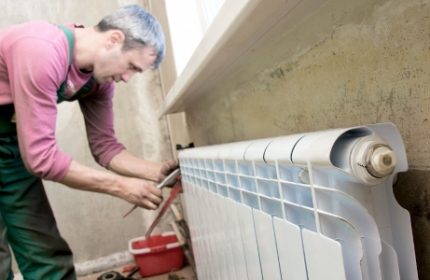
In connection with these disadvantages, it is better to connect aluminum devices to a more stable cottage heating system. It is protected not only from water shocks, but also from poor-quality coolant. If you still choose an aluminum battery for high-rise buildings with main heating, it is better to prefer anodized models.
Battery classification by manufacturing technology
For the production of heating radiators, it is not pure aluminum that is used, but its alloys with silicon. Separate sections and whole products are obtained from the blanks. The main methods of metal processing are extrusion and casting.
Type # 1 - Extrusion
On production lines, the main tool for the manufacture of extrusion devices is a molding extruder, which literally extrudes the necessary profile on metal billets.
The lack of technology is the release of individual parts, subsequently connected by pressing. Of course, the seams on the structure make it vulnerable to pressure drops and to an untreated coolant.

Extrusion models are the cheapest among aluminum. They have a smaller working surface area, which reduces the heat transfer of devices. The seams obtained as a result of pressing gradually break down from contact with poor-quality coolant.
The corrosion process is more active also because secondary aluminum is used as a raw material for extrusion, a characteristic feature of which is the presence of rapidly oxidizing impurities.
Type # 2 - Cast
Cast radiators have higher performance. They are safer, stronger and more resistant to aggressive environments than extrusion analogues, respectively, and more expensive. For the manufacture of aluminum (from 88%) and alloys with the introduction of silicon (up to 12%) are used.
Production is as follows. The molten metal enters the casting mold, where it acquires a predetermined profile. Received the design configuration of the parts are cooled, processed and checked for leaks. The walls of the blanks are treated from all sides with an anti-corrosion compound.

Various manufacturers are experimenting with casting technology, resulting in new types of radiators. Suppose Faral Trio has released a line of two-channel radiators that have not lost their strength and can cope with a burst pressure of more than 55 atm.
And the Italian radiators Radena have a vertical fins of 6 rows, due to which there is an increase in heat transfer.
If you want the heating system to be equipped with truly reliable and protected devices, pay attention to the anodized batteries. These are radiators made of aluminum coated with a durable oxide film, which has two purposes - protection and decoration.
The oxidation process several times increases the resistance of the metal to corrosion and other negative changes or reactions to the poor quality of the fluid circulating through the channels of the devices.
Technical Overview
When buying heating radiators, it is important to consider not only the appearance or connection method, but also the functional characteristics on which the operation of the heating system will depend. It is important to remember the pressure in the network and the properties of the circulating fluid.
In addition to other characteristics, the maximum temperature of the coolant is also indicated. On average, it is +110 ° C, but real indicators are usually less. For example, in urban conditions, they usually do not exceed the threshold of + 60-70 ° С (in a partially cooled state, and usually about +90 ° С at the outlet).
DIY installation instructions
If you have experience with such work, you can install the batteries yourself. For wall mounting, in addition to aluminum heating radiators, brackets and a set of tools will be required, but first you need to study some of the provisions regulated by SNiP 41-01-2003, and general installation rules.
Battery Installation Requirements
Radiators are heating devices with a coolant circulating inside, the temperature of which is higher than room temperature, therefore it is important to observe the minimum distances from the device body to the nearest significant objects:
- from the bottom to the floor - 4 cm;
- from the top to the windowsill - 5 cm;
- from the surface adjacent to the wall to the plastered wall - 2.5 cm.
But there are exceptions. If the window is too low, the upper edge of the device should be installed flush with the window sill, while the lower edge should rise at least 3 cm above the floor. If the window sill impedes air movement, the distance between the window and the radiator is allowed to be increased to 8 cm.
When replacing the radiator, the location of the pipes does not change, it is only important to choose a heater according to the connection method and size. But when arranging a new heating system, it is necessary to make the correct installation of pipes.
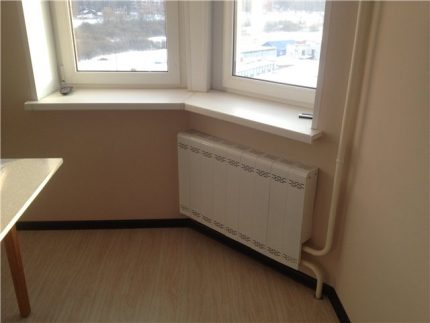
For mounting, use brackets (shelves, studs) or supports. The number of brackets depends on the heating area of the radiator: for each 1 m² - 1 pc. (at least 3 pcs for one radiator). The open installation of batteries is welcome, without camouflage screens and structures, since the amount of heat transfer is greater.
If the installation takes place in an apartment building, before installing or replacing the radiator, it is necessary to agree on a temporary disconnection of the circuit from the network. Usually, representatives of house management (plumbers) are engaged in this.
What tools and fittings will be required?
The necessary tools for assembling and connecting radiators are wire cutters, keys, pliers, an emery cloth, a brush and grease for cleaning, a pipe cutter, a chamfer. To fix the brackets on the wall, a drill with a drill bit and a set of dowels are useful.
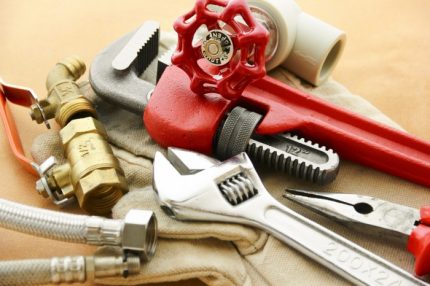
Auxiliary parts that may be required:
- shut-off and control valve (normal or for installing a thermal head);
- collector adapters with gaskets;
- Mayevsky crane (for maintenance - air bleed);
- connecting tubes made of stainless steel;
- fixture for cranes (nuts, washers).
High-quality shut-off valves and professionalism in sealing joints are the key to the long and trouble-free functioning of aluminum heating devices.
Work order
First, prepare the holes on the radiators at the joints with the pipes: clean with a brush or brush, wipe with a technical cleaner (you can use a brake). If necessary, mount adapters from one diameter to another and American. Next, pipes are also prepared, then a radiator is connected and installed.
As an example, the replacement of an old cast-iron radiator with a new aluminum analogue.
Decorative wall decoration and pipe painting produced last. At the end of all work, the riser is connected again and the radiator is checked. If it heats up quickly and evenly, installation is done correctly.
You can read the detailed instructions for installing heating radiators in this stuff.
Conclusions and useful video on the topic
The installation of various models of aluminum batteries is carried out taking into account some features, however, the basic rules for connecting and installing are approximately the same.
The entire installation process, from processing inlets to wall mounting:
Sealant assembly example:
Installing an aluminum radiator does not take much time if you have the necessary tools at hand and have the skills to work with metal. But no matter what experience you had at the time of installation, you need to act strictly according to the instructions that complete the new model.
Do you have personal experience installing or using aluminum radiators? Please share your advice with visitors to our site. Tell the intricacies of installation on which it is worth paying attention to novice home craftsmen. Leave comments in the block under the article.

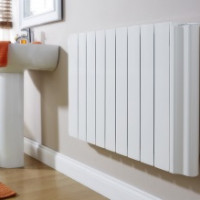 Vacuum heating radiators: overview of types, selection rules + installation technology
Vacuum heating radiators: overview of types, selection rules + installation technology  Vertical heating radiators: types + advantages and disadvantages + brand overview
Vertical heating radiators: types + advantages and disadvantages + brand overview 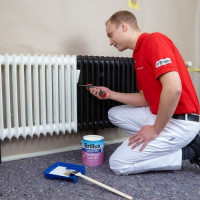 What paint to paint heating radiators: a comparative overview of the types of paint for batteries + the best manufacturers
What paint to paint heating radiators: a comparative overview of the types of paint for batteries + the best manufacturers 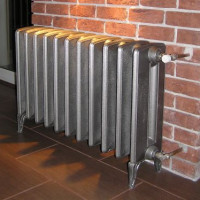 Cast-iron radiators: characteristics of batteries, their advantages and disadvantages
Cast-iron radiators: characteristics of batteries, their advantages and disadvantages  How to choose bimetal heating radiators: technical specifications + analysis of all the pros and cons
How to choose bimetal heating radiators: technical specifications + analysis of all the pros and cons  Steel heating radiators: varieties, characteristics and advantages of batteries
Steel heating radiators: varieties, characteristics and advantages of batteries  How much does it cost to connect gas to a private house: the price of organizing gas supply
How much does it cost to connect gas to a private house: the price of organizing gas supply  The best washing machines with dryer: model rating and customer tips
The best washing machines with dryer: model rating and customer tips  What is the color temperature of light and the nuances of choosing the temperature of the lamps to suit your needs
What is the color temperature of light and the nuances of choosing the temperature of the lamps to suit your needs  Replacement of a geyser in an apartment: replacement paperwork + basic norms and requirements
Replacement of a geyser in an apartment: replacement paperwork + basic norms and requirements
I set myself these about 6 years ago, the apartment has autonomous heating. There were no problems with the installation, I did everything the same as described above. My problem is different. In winter, when heated, the batteries begin to crack. Moreover, the higher the heating temperature, the more often and louder. He let the air down, water, checked the connections, nothing helps. Moreover, in two rooms there are other batteries made of steel, everything is fine with them. Or some kind of marriage, or such a feature of radiators, I do not even know.
We have the same appliances installed in our apartment. They are inexpensive, and against the background of other options, they seemed to us the most attractive. Each battery has a small faucet, so if air accumulates, you can drain it without the slightest problem. For a year I did not find any minuses in them, on the contrary: they heat up quickly, they give off heat well. They brought plastic pipes to them.